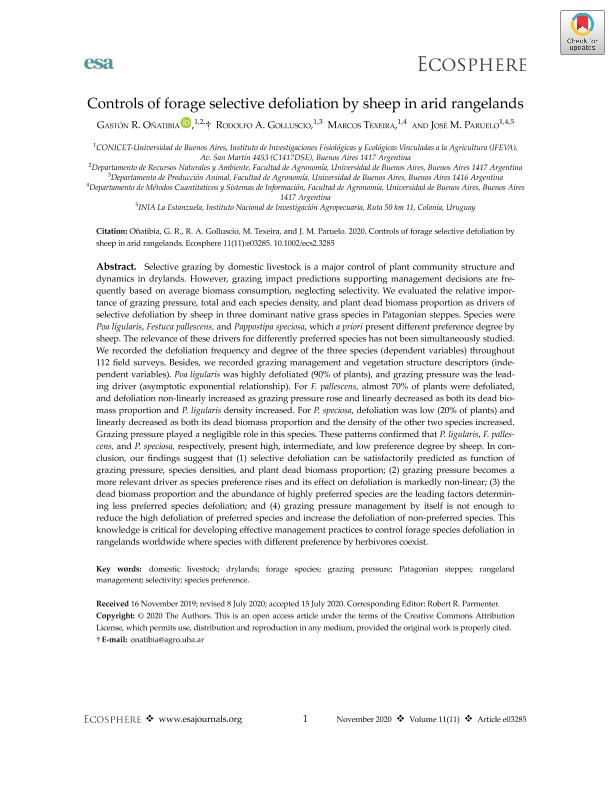Artículo
Controls of forage selective defoliation by sheep in arid rangelands
Fecha de publicación:
11/2020
Editorial:
Wiley Blackwell Publishing, Inc
Revista:
Ecosphere
ISSN:
2150-8925
e-ISSN:
2150-8925
Idioma:
Inglés
Tipo de recurso:
Artículo publicado
Clasificación temática:
Resumen
Selective grazing by domestic livestock is a major control of plant community structure and dynamics in drylands. However, grazing impact predictions supporting management decisions are frequently based on average biomass consumption, neglecting selectivity. We evaluated the relative importance of grazing pressure, total and each species density, and plant dead biomass proportion as drivers of selective defoliation by sheep in three dominant native grass species in Patagonian steppes. Species were Poa ligularis, Festuca pallescens, and Pappostipa speciosa, which a priori present different preference degree by sheep. The relevance of these drivers for differently preferred species has not been simultaneously studied. We recorded the defoliation frequency and degree of the three species (dependent variables) throughout 112 field surveys. Besides, we recorded grazing management and vegetation structure descriptors (independent variables). Poa ligularis was highly defoliated (90% of plants), and grazing pressure was the leading driver (asymptotic exponential relationship). For F. pallescens, almost 70% of plants were defoliated, and defoliation non-linearly increased as grazing pressure rose and linearly decreased as both its dead biomass proportion and P. ligularis density increased. For P. speciosa, defoliation was low (20% of plants) and linearly decreased as both its dead biomass proportion and the density of the other two species increased. Grazing pressure played a negligible role in this species. These patterns confirmed that P. ligularis, F. pallescens, and P. speciosa, respectively, present high, intermediate, and low preference degree by sheep. In conclusion, our findings suggest that (1) selective defoliation can be satisfactorily predicted as function of grazing pressure, species densities, and plant dead biomass proportion; (2) grazing pressure becomes a more relevant driver as species preference rises and its effect on defoliation is markedly non-linear; (3) the dead biomass proportion and the abundance of highly preferred species are the leading factors determining less preferred species defoliation; and (4) grazing pressure management by itself is not enough to reduce the high defoliation of preferred species and increase the defoliation of non-preferred species. This knowledge is critical for developing effective management practices to control forage species defoliation in rangelands worldwide where species with different preference by herbivores coexist.
Archivos asociados
Licencia
Identificadores
Colecciones
Articulos(IFEVA)
Articulos de INST.D/INV.FISIOLOGICAS Y ECO.VINCULADAS A L/AGRIC
Articulos de INST.D/INV.FISIOLOGICAS Y ECO.VINCULADAS A L/AGRIC
Citación
Oñatibia, Gastón Rafael; Golluscio, Rodolfo; Texeira González, Marcos Alexis; Paruelo, José; Controls of forage selective defoliation by sheep in arid rangelands; Wiley Blackwell Publishing, Inc; Ecosphere; 11; 11; 11-2020; 1-14
Compartir
Altmétricas




